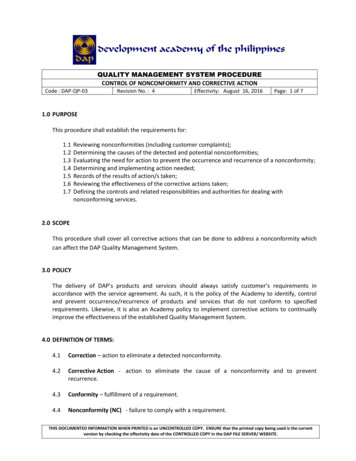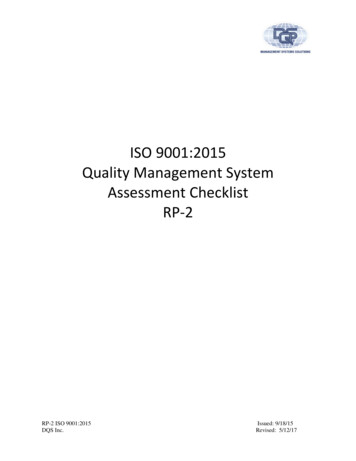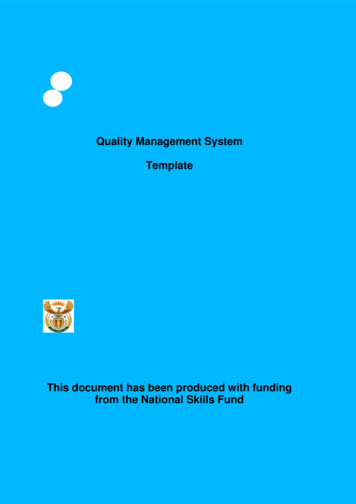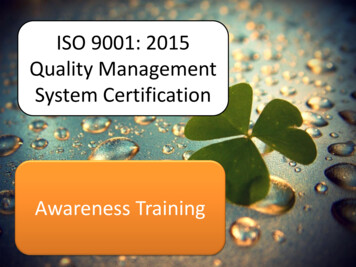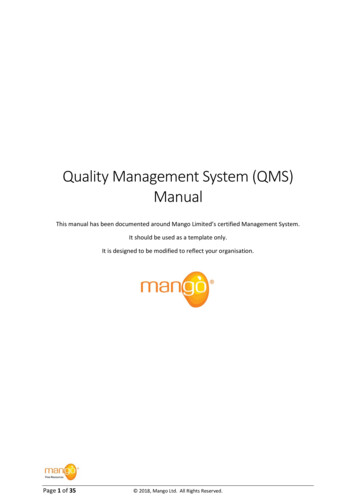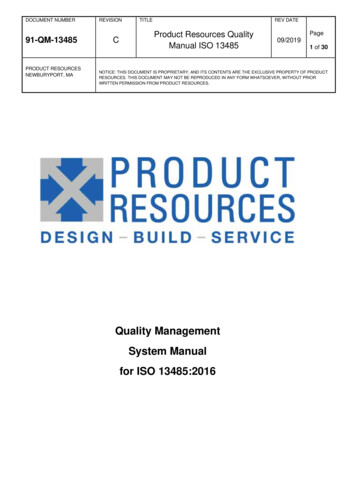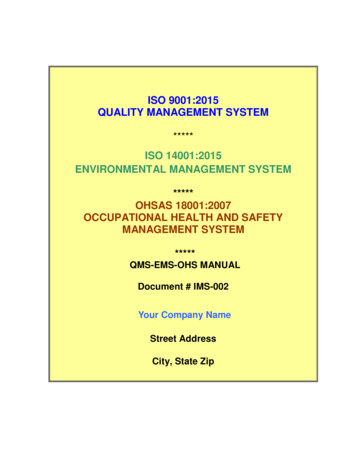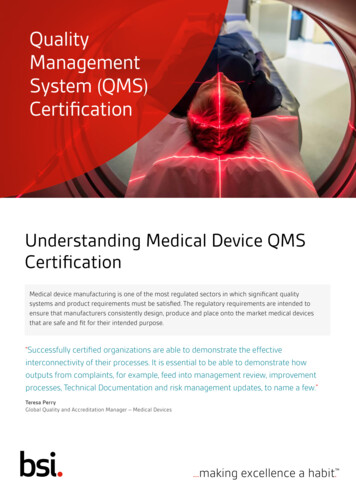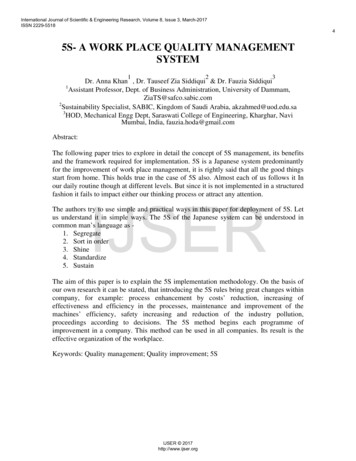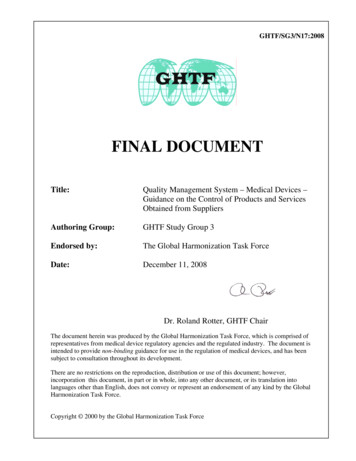
Transcription
GHTF/SG3/N17:2008FINAL DOCUMENTTitle:Quality Management System – Medical Devices –Guidance on the Control of Products and ServicesObtained from SuppliersAuthoring Group:GHTF Study Group 3Endorsed by:The Global Harmonization Task ForceDate:December 11, 2008Dr. Roland Rotter, GHTF ChairThe document herein was produced by the Global Harmonization Task Force, which is comprised ofrepresentatives from medical device regulatory agencies and the regulated industry. The document isintended to provide non-binding guidance for use in the regulation of medical devices, and has beensubject to consultation throughout its development.There are no restrictions on the reproduction, distribution or use of this document; however,incorporation this document, in part or in whole, into any other document, or its translation intolanguages other than English, does not convey or represent an endorsement of any kind by the GlobalHarmonization Task Force.Copyright 2000 by the Global Harmonization Task Force
Guidance on the control of products and services obtained from suppliers.GHTF/SG3/N17R9:2008Table of Contents1.02.03.0Scope. 5Definitions. 62.1Supplier (ISO 9000:2005, Clause 3.3.6). 62.2Product (ISO 9000:2005, Clause 3.4.2):. 62.3Process (ISO 9000:2005, Clause 3.4.1) . 72.4Objective evidence (ISO9000:2005, Clause 3.8.1). 72.5Manufacturer (GHTF SG1 N055R6, section 4.1). 7General Principles. 83.1Planning . 113.1.1 Product or service to be obtained from supplier(s). 113.1.2 Technical and process information . 123.1.3 Identification of potential supplier(s). 123.1.4 Identification of risk(s) . 123.1.5 Identification of controls. 133.2Selection of potential suppliers. 143.2.1 Supplier business capability. 143.2.2 Supplier operational capability . 143.2.3 Selection of potential supplier . 153.3Supplier evaluation and acceptance . 153.3.1 Planning for evaluation and selection criteria. 153.3.2 Communicate with potential suppliers. 163.3.3 Evaluation of potential supplier s ability. 163.3.4 Supplier acceptance . 173.4Finalization of controls . 183.5Delivery, measurement and monitoring. 193.6Feedback and communication. 20December 11, 2008Page 2 of 21
Guidance on the control of products and services obtained from suppliers.GHTF/SG3/N17R9:2008PrefaceThe document herein was produced by the Global Harmonization Task Force, a voluntary groupof representatives from medical device regulatory agencies and the regulated industry. Thedocument is intended to provide non-binding guidance for use in the regulation of medicaldevices, and has been subject to consultation throughout its development.There are no restrictions on the reproduction, distribution or use of this document; however,incorporation of this document, in part or in whole, into any other document, or its translationinto languages other than English, does not convey or represent an endorsement of any kind bythe Global Harmonization Task Force.December 11, 2008Page 3 of 21
Guidance on the control of products and services obtained from suppliers.GHTF/SG3/N17R9:2008IntroductionThis guidance document is intended for medical device manufacturers and it is expected that thereader is familiar with regulatory quality management system requirements within the medicaldevices sector. This guidance document may also be useful to regulatory authorities andsuppliers. This guidance document is intended for educational purposes and it is not intended tobe used to assess or audit compliance with regulatory requirements.Existing regulatory requirements, such as Sections 4.1 and 7.4 of ISO13485:2003, Articles 5 and37 through 39 of the Japanese Ministerial Ordinance on Standards for Manufacturing Controland Quality Control for Medical Devices and in vitro Diagnostics (MHLW MinisterialOrdinance No. 169, 2004), and the FDA 1996 Quality System Regulation 21 CFR Part 820,sections 820.50 Purchasing controls, and 820.80 Receiving, in-process, and finished deviceacceptance, which require organizations to control products and services obtained fromsuppliers. These requirements call for the type and extent of controls to be established anddocumented within the organization’s quality management system. Control could be defined anddocumented in the form of contractual arrangements, quality plans or other types of documents.Several medical device quality management system regulations have their requirementsharmonized around ISO 9001. Clause 4.1 of ISO 9001:2000 utilizes the term “outsourcedprocesses”, however, it is not defined in the vocabulary standard ISO 9000:2005. There are norequirements within ISO 9001:2000 related to outsourced processes beyond what is found inclause 4.1. Clause 7.4 defines purchasing requirements in the terms of “purchased product” and“suppliers”, but does not include or reference outsourced processes from clause 4.1. This has ledto differing interpretations regarding the controls of outsourced processes as they relate topurchasing controls in clause 7.4 of ISO 9001:2000 and the quality management systemrequirements for medical device manufacturers derived from this standard.ISO TC 176, the authoring group of the ISO 9000 series of standards, has published a guidancedocument intended to clarify ISO 9001:2000 clause 4.1, regarding the control of outsourcedprocesses titled ISO 9000 Introduction and support package: Guidance on outsourced processes.Clause 2.2 of this document states:The intent of Clause 4.1 of ISO 9001:2000 is to emphasize that when an organizationchooses to outsource (either permanently or temporarily) a process that affects productconformity with requirements (see ISO 9001:2000 clause 7.2.1) it cannot simply ignorethis process, nor exclude it from the quality management system.The organization has to demonstrate that it exercises sufficient control to ensure that thisprocess is performed according to the relevant requirements of ISO 9001:2000, and anyother requirements of the organization's quality management system. The nature of thiscontrol will depend, among other things, on the importance of the outsourced process,the risk involved, and the competence of the supplier to meet the process requirements.Outsourced processes will interact with other processes from the organization's qualitymanagement system (these other processes may be carried out by the organization itself,December 11, 2008Page 4 of 21
Guidance on the control of products and services obtained from suppliers.GHTF/SG3/N17R9:2008or may themselves be outsourced processes). These interactions also need to bemanaged (see ISO 9001:2000 clause 4.1 [a] and [b]).1Therefore, when a medical device manufacturer chooses to utilize suppliers, the manufacturershould ensure control over any product or service obtained from such suppliers as defined withinthe quality management system (QMS). The controls may extend further if a suppliersubcontracts work.The remainder of this document will not utilize the term “outsourced processes”.1.0 ScopeThis document provides guidance for medical device manufacturers on the control of productsand services obtained from suppliers.For the purposes of this document, a product or service is one which is purchased or otherwiseobtained by the manufacturer. In addition, a supplier is anyone that is independent from themanufacturer’s quality management system. This includes a supplier that may be part of themanufacturer’s organization but operates under a separate quality management system. Forexample, if the supplier is not a part of the manufacturer’s internal audit scope, then the supplieris under a separate quality management system and is considered an internal supplier.Corporations or companies that have corporate quality policies and procedures do not necessarilyplace all divisions or groups under the same quality management system. Therefore, onedivision or group can be an internal supplier to another division or group within the samecorporation/company. Internal suppliers are to be controlled in a similar way as externalsuppliers are controlled.Manufacturers are required to define and document the type and extent of controls applied tosuppliers and to maintain objective evidence that products and services meet predefinedspecifications. These documents and records are subject to regulatory evaluation and thereforeshould be present or readily available at the manufacturer’s site. Failure to provide access to orhave objective evidence of the controls associated with supplier activities could result in a majornoncompliance.2This guidance document is also applicable to combination products which are regulated asmedical devices. However, regulations may impose additional or differing requirements onsuppliers and/or manufacturers of combination products (device/drug, device/tissue,device/biologic, etc.).1ISO/TC 176/SC 2/N630R2 ISO 9000 Introduction and Support Package: Guidance on ‘Outsourced Processes,dated 24 November 20032GHTF/SG4/N28 Guidelines for Regulatory Auditing of Quality Management Systems of Medical DeviceManufacturers Part 1: General RequirementsDecember 11, 2008Page 5 of 21
Guidance on the control of products and services obtained from suppliers.GHTF/SG3/N17R9:20082.0 DefinitionsThe references to clauses in this section refer to ISO 9000:2005. Medical device specificexamples are given in the body of this guidance.2.1Supplier (ISO 9000:2005, Clause 3.3.6)organization (3.3.1) or person that provides a product (3.4.2)EXAMPLE Producer, distributor, retailer or vendor of a product, or provider of a service orinformation.NOTE 1 A supplier can be internal or external to the organization.NOTE 2 In a contractual situation a supplier is sometimes called “contractor”.2.2Product (ISO 9000:2005, Clause 3.4.2):result of a process (3.4.1)NOTE 1 There are four generic product categories, as follows:— services (e.g. transport);— software (e.g. computer program, dictionary);— hardware (e.g. engine mechanical part);— processed materials (e.g. lubricant).Many products comprise elements belonging to different generic product categories. Whether theproduct is then called service, software, hardware or processed material depends on the dominantelement. For example the offered product “automobile” consists of hardware (e.g. tyres),processed materials (e.g. fuel, cooling liquid), software (e.g. engine control software, driver'smanual), and service (e.g. operating explanations given by the salesman).NOTE 2 Service is the result of at least one activity necessarily performed at the interfacebetween the supplier (3.3.6) and customer (3.3.5) and is generally intangible. Provision of aservice can involve, for example, the following:— an activity performed on a customer-supplied tangible product (e.g. automobile to berepaired);— an activity performed on a customer-supplied intangible product (e.g. the incomestatement needed to prepare a tax return);— the delivery of an intangible product (e.g. the delivery of information in the context ofknowledge transmission);— the creation of ambience for the customer (e.g. in hotels and restaurants).Software consists of information and is generally intangible and can be in the form ofapproaches, transactions or procedures (3.4.5).December 11, 2008Page 6 of 21
Guidance on the control of products and services obtained from suppliers.GHTF/SG3/N17R9:2008Hardware is generally tangible and its amount is a countable characteristic (3.5.1). Processedmaterials are generally tangible and their amount is a continuous characteristic. Hardware andprocessed materials often are referred to as goods.NOTE 3 Quality assurance (3.2.11) is mainly focused on intended product.2.3Process (ISO 9000:2005, Clause 3.4.1)set of interrelated or interacting activities which transforms inputs into outputsNOTE 1 Inputs to a process are generally outputs of other processes.NOTE 2 Processes in an organization (3.3.1) are generally planned and carried out undercontrolled conditions to add value.NOTE 3 A process where the conformity (3.6.1) of the resulting product (3.4.2) cannot bereadily or economically verified is frequently referred to as a “special process”.2.4Objective evi
documented in the form of contractual arrangements, quality plans or other types of documents. Several medical device quality management system regulations have their requirements harmonized around ISO 9001. Clause 4.1 of ISO 9001:2000 utilizes the term “outsourced processes”, however, it is not defined in the vocabulary standard ISO 9000 .
